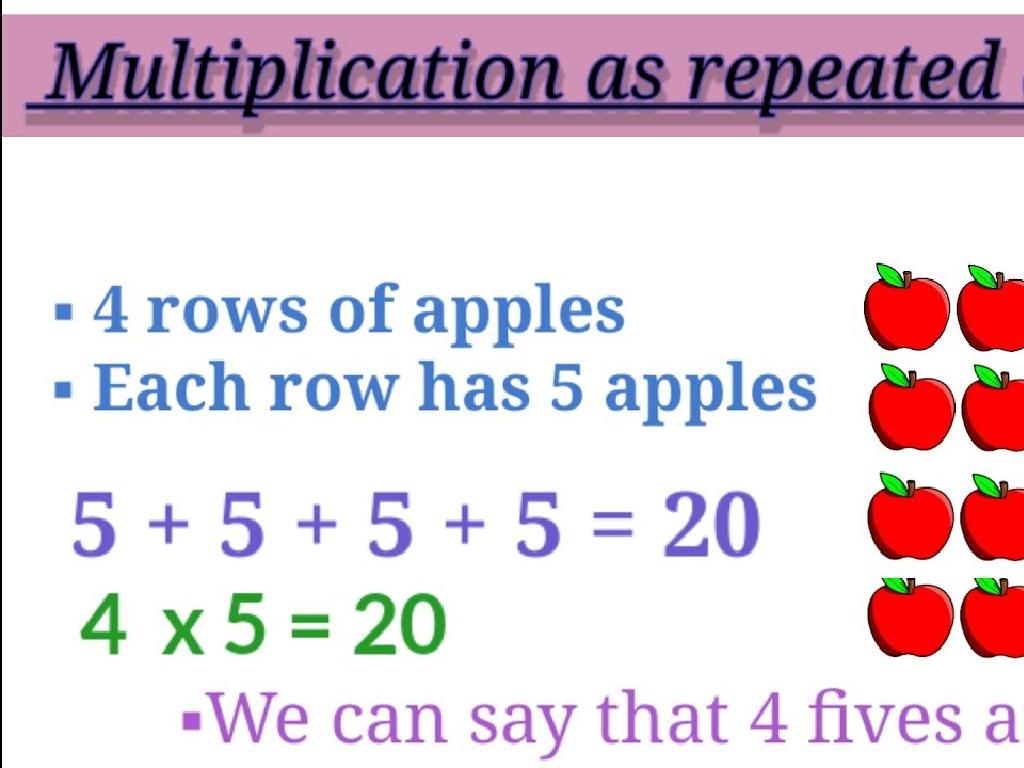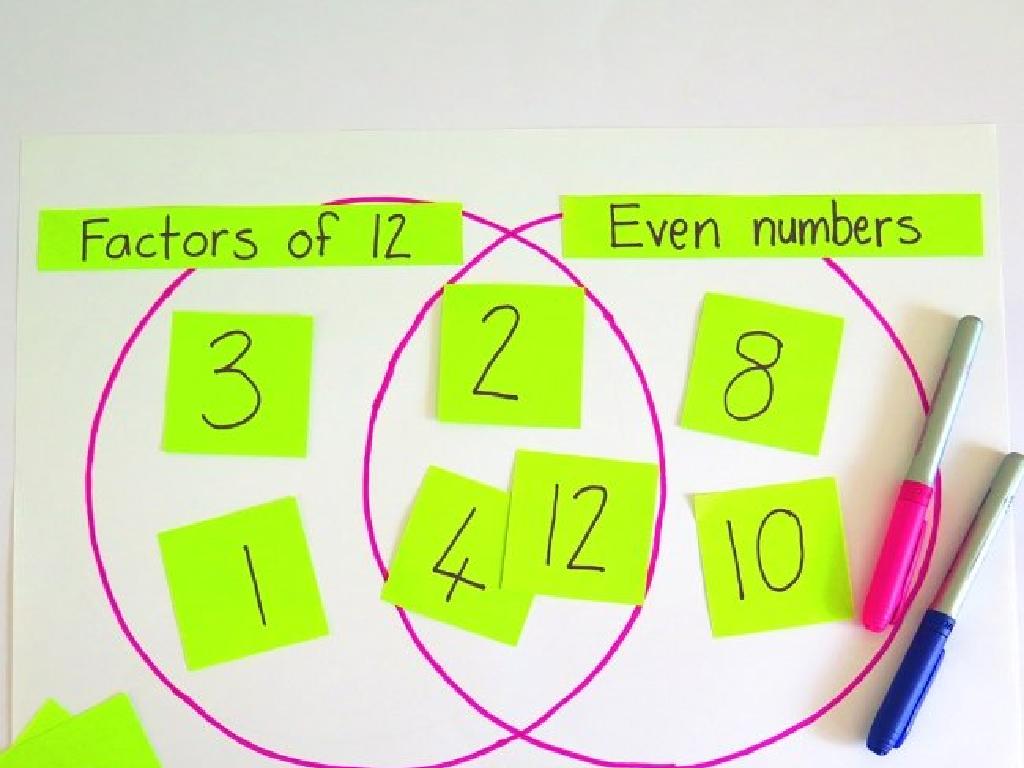Which Bar Graph Is Correct?
Subject: Math
Grade: Second grade
Topic: Data And Graphs
Please LOG IN to download the presentation. Access is available to registered users only.
View More Content
Understanding Bar Graphs
– What is a bar graph?
– It’s a chart that shows numbers as bars of different lengths.
– How to read bar graphs
– Look at the height or length of the bars to know the numbers they represent.
– Creating your own bar graph
– We’ll draw bars to show different amounts like pets in our homes.
– Importance of bar graphs
– They help us compare different things easily, like favorite fruits.
|
This slide introduces second-grade students to the concept of bar graphs. Begin by explaining that a bar graph is a visual way to show numbers with bars of different lengths. Teach them how to read a bar graph by looking at the height or length of the bars to understand the value each bar represents. Engage the students in an activity where they create their own bar graph, perhaps using a simple survey of the class, like the number of pets each student has. Emphasize the importance of bar graphs in everyday life, such as comparing how many pieces of different types of fruit are in the fruit bowl at home. This will help them understand how bar graphs can be used to display and compare information clearly and effectively.
Understanding Bar Graphs
– What is a bar graph?
– It’s a chart with bars showing data
– Bar graphs compare different groups
– Like comparing favorite fruits in class
– Each bar shows a category’s value
– Taller or longer bars mean bigger numbers
– Practice: Which graph is correct?
– We’ll look at examples and decide
|
This slide introduces second graders to the concept of bar graphs as a visual tool for representing data. Begin by explaining that a bar graph uses bars to show information and that the height or length of each bar is important because it shows how much or how many. Use relatable examples, such as comparing the number of different favorite fruits among classmates, to illustrate how bar graphs work. Each bar corresponds to a different fruit and the height shows how many students prefer that fruit. After explaining the basics, engage the students with an activity where they look at different bar graphs and determine which one correctly represents a given set of data. This will help them apply their understanding of bar graphs to real examples.
Parts of a Bar Graph
– Graph Title: What’s the graph about?
– Like the title of a book, it tells us the topic of the graph.
– Categories: What we compare
– Categories are different things we are looking at, like types of fruit.
– Values: How much or how many
– Values tell us the amount. If we have 5 apples, the value is 5.
– Bars: Show value for each category
– Each bar’s height shows how many or how much of something we have.
|
This slide introduces the basic components of a bar graph to second-grade students. The title of the graph gives the overall topic, similar to a story’s title. Categories, usually on the x-axis, are the items we’re comparing, such as different kinds of fruits or colors of marbles. Values indicate the quantity or amount and are found on the y-axis; they could represent things like the number of apples or the number of sunny days in a week. Bars of different heights visually represent these values, making it easy to compare the categories at a glance. Encourage students to think of their own examples and understand that each part of the graph helps us to quickly understand the information being presented.
Reading a Bar Graph Correctly
– Understand the graph’s title
– The title tells us what information the graph is showing.
– Check the categories compared
– Categories are the different things we are looking at.
– Read the values on the graph
– Values tell us ‘how much’ or ‘how many’ for each category.
– Compare the bar lengths
– Longer bars show more, shorter bars show less.
|
This slide is aimed at teaching second-grade students how to read a bar graph correctly. Start by explaining that the title of the graph gives us an idea of what information we will find on the graph. Then, show them how to look at the categories on the x-axis to understand what is being compared. Next, guide them to read the values on the y-axis to see how much or how many of each category is represented. Finally, help them to compare the lengths of the bars to determine which category has the most or the least. Use simple and relatable examples, such as comparing the number of apples and oranges sold in a week, to make the concept clear. Encourage students to practice with different bar graphs and to explain their findings.
Creating a Bar Graph
– Choose a topic for data collection
– Decide on categories and values
– Draw and label the axes
– X-axis for categories, Y-axis for values
– Represent data with bars
– Bars show data size visually
|
This slide introduces the steps to create a bar graph, which is a visual representation of data. Start by choosing a topic that interests the students, such as favorite fruits or pets in the class. Then, guide them to decide on the categories (e.g., types of fruits) and the values (e.g., number of students who like each fruit). Next, demonstrate how to draw the axes on graph paper, with the horizontal axis (X-axis) representing the categories and the vertical axis (Y-axis) representing the values. Finally, show them how to draw the bars corresponding to the data collected, ensuring that each bar’s height reflects the value it represents. Encourage students to be precise in their measurements and to check that their graph accurately reflects their data. This activity will help them understand how to interpret and create bar graphs, a key skill in data representation.
Which Bar Graph is Correct?
– Examine two bar graphs
– Check titles, labels, and bars
– Ensure each graph has a clear title, and the axes are labeled correctly.
– Match graphs with given data
– Do the bars represent the data accurately? Are the heights correct?
– Use knowledge to find errors
– Look for anything that doesn’t seem right based on what we know.
|
This slide is aimed at teaching second-grade students how to critically analyze bar graphs to determine their accuracy. Start by presenting two different bar graphs to the class. Guide the students through a step-by-step process of verifying the correctness of each graph. Check if the title of the graph gives a clear understanding of what data is being represented. Ensure that the labels on the axes are correct and that the bars accurately reflect the data provided. Engage the students by asking them to use their knowledge of bar graphs to spot any discrepancies or mistakes. This activity will reinforce their understanding of how to interpret data presented in a bar graph format and how to ensure its accuracy.
Class Activity: Make Your Own Bar Graph!
– Collect class data on favorite fruits
– Create your personal bar graph
– Use the data to draw bars for each fruit
– Label your graph clearly
– Include a title, and label the x and y axes
– Review your graph for accuracy
– Double-check the height of bars matches the data
|
This activity is designed to give students hands-on experience with data collection and representation through bar graphs. Start by facilitating a class discussion to decide on the fruits to include and gather data on each student’s favorite fruit. Guide the students through the process of creating a bar graph, emphasizing the importance of accurate representation and clear labeling. Provide them with graph paper and colored pencils or markers. Encourage creativity while ensuring the graphs are mathematically correct. After completion, have students present their graphs to the class to practice their speaking skills and to learn from each other’s work. Possible variations of the activity could include grouping students to work on larger data sets or comparing favorite fruits between boys and girls.
Bar Graphs Mastery
– Congratulations on learning bar graphs!
– You can now read and make bar graphs.
– Always ensure your graph’s accuracy.
– Double-check the title, labels, and data.
– Practice makes perfect with graphs!
– Keep practicing by creating graphs from different data sets.
|
This slide is a celebration of the students’ achievement in understanding how to read and create bar graphs. It’s important to reinforce the concept of accuracy in their work. Remind them to always check the title to ensure it matches the data, verify that the axes are labeled correctly, and confirm that the data is represented accurately. Encourage them to continue practicing with various data sets to become more confident in their graphing skills. You can suggest that they create bar graphs of their favorite snacks, pets in the class, or even the colors of cars they see on their way home.






